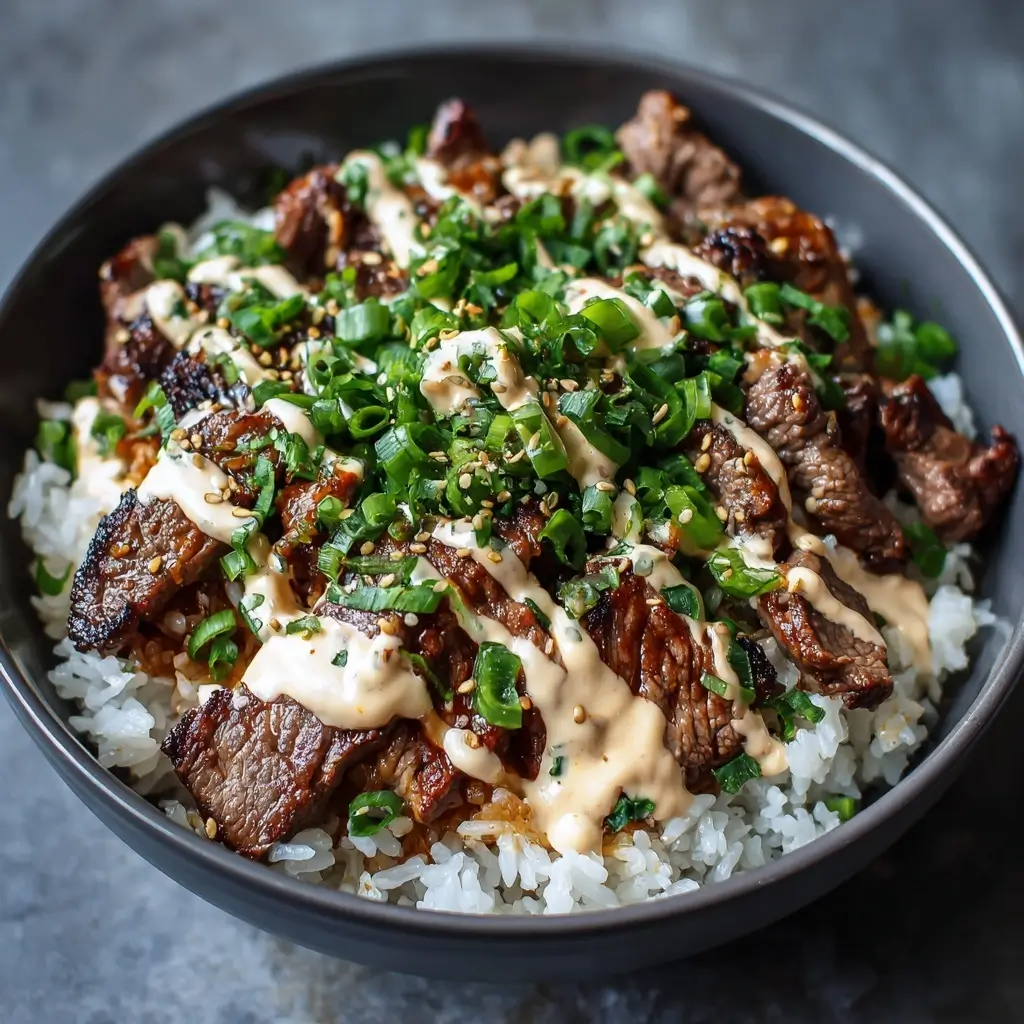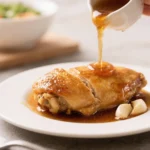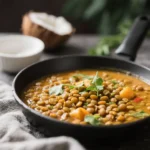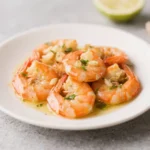Korean BBQ Steak Rice Bowls with Spicy Cream Sauce
If you’re craving a bold, savory, and satisfying meal that combines the rich flavors of Korean barbecue with the comfort of a hearty rice bowl, then these Korean BBQ Steak Rice Bowls with Spicy Cream Sauce are exactly what you need. This fusion dish brings together tender marinated steak, fluffy jasmine rice, fresh vegetables, and a luscious spicy cream sauce that ties everything together in perfect harmony. Whether you’re cooking for a weeknight dinner or impressing guests at a weekend gathering, this recipe delivers restaurant-quality flavor with home-cooked warmth. With layers of umami, heat, sweetness, and texture, each bite is an explosion of taste that will have everyone asking for seconds.
The History
Korean cuisine has long been celebrated for its balance of bold flavors, fermented ingredients, and communal dining experiences. Dishes like bulgogi (marinated grilled beef) and bibimbap (mixed rice bowls) have roots stretching back centuries, evolving through royal court meals and regional variations across the Korean peninsula. The concept of Korean barbecue—grilling meat at the table—became popular in the 20th century and gained international fame as Korean culture spread globally.
The modern twist of combining Korean-style steak with creamy, spicy sauces reflects a growing trend of Asian-fusion cuisine, particularly in North America and Western Europe. Chefs and home cooks alike began experimenting with blending traditional Korean marinades—rich in soy sauce, garlic, sesame, and pear—with Western techniques and ingredients such as cream-based sauces, allowing for new dimensions of flavor. The “spicy cream sauce” seen in this recipe draws inspiration from dishes like spicy Korean fried chicken and ramen, where gochujang (fermented chili paste) meets dairy to create a velvety, fiery kick. This dish, while not traditional, honors the spirit of Korean culinary innovation by fusing heritage flavors with contemporary creativity.
Ingredients Breakdown
To craft the perfect Korean BBQ Steak Rice Bowl with Spicy Cream Sauce, it’s essential to understand the role each ingredient plays. Here’s a detailed breakdown:
- Flank Steak or Ribeye: These cuts are ideal due to their tenderness and ability to absorb marinade. Flank steak offers a leaner profile with deep beefy flavor, while ribeye brings more marbling and juiciness.
- Soy Sauce: Provides saltiness and umami depth. Use low-sodium soy sauce if you prefer better control over salt levels.
- Brown Sugar: Adds sweetness to balance the salt and spice. It also aids in caramelization during cooking.
- Sesame Oil: Imparts a nutty aroma and enhances the overall richness of the marinade and sauce.
- Rice Vinegar: Offers a subtle tang that brightens the marinade and prevents the meat from becoming too heavy.
- Fresh Garlic & Ginger: Essential aromatics that bring pungency and warmth, foundational in Korean flavor profiles.
- Sriracha or Gochujang: For heat. Sriracha gives a vinegary kick, while gochujang adds fermented complexity and deeper red color.
- Water or Pineapple Juice: Helps tenderize the meat. Pineapple juice contains natural enzymes (bromelain) that break down proteins gently.
- Jasmine Rice: The fragrant, slightly sticky base that soaks up sauces beautifully. Can be substituted with brown rice or cauliflower rice for dietary preferences.
- Vegetables: Thinly sliced cucumbers, shredded carrots, pickled radish, scallions, and sautéed mushrooms add freshness, crunch, and color contrast.
- Butter & Heavy Cream: Used in the spicy cream sauce to create a luxurious, silky texture.
- Green Onions & Sesame Seeds: Garnishes that elevate both presentation and flavor with a pop of freshness and nuttiness.
Step-by-Step Recipe
- Marinate the Steak: In a large bowl, whisk together 1/4 cup soy sauce, 2 tablespoons brown sugar, 1 tablespoon sesame oil, 1 tablespoon rice vinegar, 1 teaspoon sriracha (or 1 tbsp gochujang), 3 minced garlic cloves, 1 tablespoon grated ginger, and 1/4 cup pineapple juice. Place 1.5 lbs flank steak (sliced against the grain into thin strips) into a resealable bag or shallow dish. Pour marinade over the steak, ensuring all pieces are coated. Refrigerate for at least 2 hours, preferably 4–8 hours for maximum flavor infusion.
- Cook the Rice: Rinse 1 cup jasmine rice under cold water until the water runs clear. Combine with 1.5 cups water in a saucepan. Bring to a boil, then reduce heat to low, cover, and simmer for 15–18 minutes until water is absorbed and rice is fluffy. Remove from heat and let sit covered for 5 minutes. Fluff with a fork and set aside.
- Prepare the Vegetables: While the steak marinates, slice 1 cucumber and 2 carrots into matchsticks. Julienne half a small red cabbage. Chop 4 scallions. Optionally, quick-pickle the vegetables: combine them in a bowl with 1/4 cup rice vinegar, 1 tsp sugar, and a pinch of salt. Let sit for 20–30 minutes for a tangy crunch.
- Cook the Steak: Heat 1 tablespoon vegetable oil in a cast-iron skillet or grill pan over high heat. Remove steak from marinade (shake off excess) and sear in batches for 2–3 minutes per side until nicely charred and cooked to medium doneness. Avoid overcrowding the pan to ensure proper browning. Transfer to a plate and tent with foil to rest.
- Make the Spicy Cream Sauce: In the same pan (reduce heat to medium), melt 2 tablespoons butter. Add 1 minced garlic clove and cook for 30 seconds. Stir in 1 tablespoon gochujang or sriracha (adjust to taste). Gradually pour in 1/2 cup heavy cream, stirring constantly. Simmer gently for 3–4 minutes until slightly thickened. Season with a dash of soy sauce and black pepper. For extra richness, stir in 1 tablespoon cream cheese or sour cream.
- Assemble the Bowls: Divide cooked rice among four serving bowls. Top with slices of grilled steak. Arrange colorful vegetables around the bowl. Drizzle generously with the spicy cream sauce. Garnish with sliced green onions and toasted sesame seeds. Serve immediately.
Tips
- Don’t Over-Marinate Tough Cuts: While flank steak benefits from longer marination, avoid exceeding 12 hours as the acidity can begin to “cook” the meat and make it mushy.
- Slice Against the Grain: This is crucial for tender bites. Identify the direction of the muscle fibers and cut perpendicular to them.
- Rest the Meat: Letting the steak rest after cooking allows juices to redistribute, keeping each slice moist and flavorful.
- Control the Heat: Adjust the amount of gochujang or sriracha based on your spice tolerance. You can always add more, but you can’t take it away!
- Use Fresh Aromatics: Pre-minced garlic or powdered ginger won’t deliver the same vibrant punch as freshly grated versions.
- Toast the Sesame Seeds: Lightly toast them in a dry pan for 1–2 minutes until golden and fragrant. This intensifies their nutty flavor.
- Double the Sauce: The spicy cream sauce is so delicious, many will want extra. Consider making a larger batch—it also keeps well in the fridge for up to 5 days.
- Grill Option: For authentic smoky flavor, grill the marinated steak over charcoal or gas instead of using a stovetop pan.
Variations and Customizations
This recipe is highly adaptable to suit different tastes, dietary needs, and ingredient availability:
- Protein Swaps: Replace steak with thinly sliced chicken breast, pork tenderloin, tofu, or even portobello mushrooms for a vegetarian option. Each absorbs the marinade well and pairs beautifully with the spicy cream sauce.
- Rice Alternatives: Try brown rice, forbidden black rice, quinoa, or cauliflower rice for lower-carb or whole-grain options. Coconut rice adds a tropical twist.
- Sauce Variations: Swap heavy cream for coconut milk to make the sauce dairy-free and subtly sweet. Add miso paste (1 tsp) for deeper umami. For a tangier profile, mix in a splash of lime juice or kimchi brine.
- Add Kimchi: Spoon a few tablespoons of store-bought or homemade kimchi on top for fermentation-powered heat and probiotics.
- Egg Upgrade: Top each bowl with a soft-boiled or sunny-side-up egg. The runny yolk blends luxuriously with the spicy cream sauce.
- Noodle Version: Turn this into a noodle bowl by replacing rice with udon, soba, or glass noodles.
- Low-Sugar Option: Substitute brown sugar with monk fruit sweetener or erythritol, and use sugar-free gochujang if available.
- Mild Version: Omit spicy elements entirely for a creamy sesame-garlic sauce that kids and spice-sensitive eaters will love.
Health Considerations and Nutritional Value
While undeniably indulgent, this dish can be part of a balanced diet with mindful adjustments. Here’s a nutritional estimate per serving (based on 4 servings):
- Calories: ~650–750 kcal (depending on steak cut and cream amount)
- Protein: ~35–40g (excellent source from beef and dairy)
- Fat: ~30–40g (mostly unsaturated from sesame oil and some saturated from cream and steak)
- Carbohydrates: ~50–60g (primarily from rice and sugar in marinade)
- Sodium: ~900–1200mg (moderate to high; reduce with low-sodium soy sauce)
- Fiber: ~3–5g (from vegetables and optional whole grains)
Health Tips:
- Choose leaner cuts like flank or sirloin to reduce saturated fat.
- Limited processed sugars by reducing brown sugar or using natural alternatives.
- Increase fiber and micronutrients by loading up on colorful vegetables—add spinach, bell peppers, or bean sprouts.
- Use Greek yogurt instead of heavy cream for a lighter, protein-rich sauce alternative.
- Balance the meal by serving with a side of miso soup or a simple seaweed salad.
- Those with hypertension should monitor sodium intake; rinsing canned items and using reduced-sodium products helps.
- For keto or low-carb diets, serve over sautéed cabbage or zucchini noodles and omit sugar from the marinade.
Ingredients
- 1.5 lbs flank steak or ribeye, thinly sliced
- 1/4 cup soy sauce (low-sodium preferred)
- 2 tbsp brown sugar (or coconut sugar)
- 1 tbsp sesame oil
- 1 tbsp rice vinegar
- 1 tbsp sriracha or 1–2 tbsp gochujang (adjust to taste)
- 1/4 cup pineapple juice (or water)
- 4 cloves garlic, minced
- 1 tbsp fresh ginger, grated
- 1 cup jasmine rice
- 1.5 cups water (for rice)
- 1 tbsp vegetable oil (for cooking steak)
- 2 tbsp butter (for sauce)
- 1/2 cup heavy cream (or coconut milk)
- 1 tsp cream cheese or sour cream (optional, for richness)
- 1 cucumber, julienned
- 2 carrots, julienned
- 1/2 red cabbage, shredded
- 4 scallions, sliced
- 1 tbsp sesame seeds, toasted
- Salt and pepper to taste
Directions
- In a mixing bowl, whisk together soy sauce, brown sugar, sesame oil, rice vinegar, sriracha (or gochujang), pineapple juice, minced garlic, and grated ginger. Place sliced steak in a resealable plastic bag or container and pour marinade over it. Seal and refrigerate for 2–8 hours.
- Rinse jasmine rice under cold water until water runs clear. Combine rice and water in a saucepan. Bring to a boil, then reduce heat to low, cover, and simmer for 15–18 minutes. Remove from heat, let stand for 5 minutes, then fluff with a fork.
- While rice cooks, prepare vegetables. Julienne cucumber and carrots, shred cabbage, and slice scallions. Optionally, quick-pickle by tossing with 1/4 cup rice vinegar, 1 tsp sugar, and a pinch of salt. Set aside.
- Heat vegetable oil in a large skillet or grill pan over high heat. Remove steak from marinade and shake off excess. Sear in batches for 2–3 minutes per side until browned and cooked through. Transfer to a plate and cover loosely with foil.
- In the same pan, reduce heat to medium and melt butter. Add 1 minced garlic clove and sauté for 30 seconds. Stir in sriracha or gochujang, then slowly whisk in heavy cream. Simmer for 3–4 minutes until sauce thickens slightly. Stir in cream cheese (if using) and season with a dash of soy sauce and black pepper.
- To assemble, divide rice among four bowls. Top with steak slices, arranged vegetables, and a generous drizzle of spicy cream sauce. Garnish with green onions and toasted sesame seeds. Serve immediately while hot.
FAQ
Can I make this ahead of time?
Yes! Marinate the steak up to 24 hours in advance. Cook the rice and prep vegetables earlier in the day. Reheat rice with a splash of water to restore moisture. Cook steak and sauce just before serving for best texture.
Is gochujang necessary, or can I skip it?
Gochujang adds authentic Korean depth, but you can substitute with sriracha, sambal oelek, or even harissa. Note: the flavor will differ slightly—less sweet and fermented—but still spicy and delicious.
Can I freeze leftovers?
The steak and rice can be frozen separately for up to 3 months. Thaw overnight in the fridge and reheat in a skillet or microwave. The spicy cream sauce may separate slightly when reheated—stir in a splash of cream or broth to revive smoothness.
What if I don’t have pineapple juice?
Use apple juice, orange juice, or plain water. Pineapple is preferred for its natural tenderizing enzymes, but others work fine for flavor and moisture.
How do I make this gluten-free?
Use tamari or a certified gluten-free soy sauce. Ensure all other ingredients (like gochujang) are labeled gluten-free, as some brands contain wheat.
Can I use pre-cooked rice?
Absolutely. Leftover rice works well, especially if slightly dried out—it fries better and doesn’t get mushy. Just warm it thoroughly before assembling.
Why did my steak turn out tough?
Possible reasons: overcooking, slicing with the grain, or using a less tender cut. Always slice against the grain and avoid cooking beyond medium to preserve tenderness.
Summary
Korean BBQ Steak Rice Bowls with Spicy Cream Sauce blend the savory-sweet notes of traditional bulgogi with a modern, creamy kick that elevates every bite. Packed with tender marinated steak, fluffy rice, crisp vegetables, and a rich, fiery sauce, this dish is a flavor-packed celebration of Korean-inspired comfort food.










